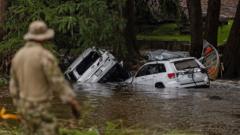Are Texas Storms Highlighting the Dangers of Trump's Weather Agency Cuts?

Understanding the Impact of Staffing Cuts on Weather Services in the U.S.
The devastating storms that swept across Texas' Hill Country during the 4th of July holiday have drawn attention to the long-standing issue of staffing and funding within key governmental weather agencies. With multiple months' worth of rain falling in just a few hours, the aftermath has left communities grappling with loss—both in terms of infrastructure and human life. This tragedy prompts an urgent discussion about the ability of the National Oceanic and Atmospheric Administration (NOAA) and its subsidiary, the National Weather Service (NWS), to adequately protect the public from increasingly severe weather events.
The Recent Storms: A Case Study in Weather Catastrophes
The storms that hit Texas were particularly intense, resulting in catastrophic flash floods that claimed lives and left many missing. This event stands as the deadliest weather disaster in the U.S. since significant staffing cuts were enacted within NOAA and NWS during the Trump administration. While the NWS was able to issue timely alerts during this crisis, the situation raises critical questions about the agencies' future capabilities if current staffing levels and funding continue to decline.
The Role of the National Weather Service
The NWS plays a pivotal role in weather forecasting and disaster preparedness. It employs meteorologists, hydrologists, and technical specialists to analyze weather data and provide early warnings to communities. However, recent staffing cuts have significantly affected the agency's ability to function effectively.
Staffing Challenges at NWS
As of February, the NWS has lost approximately 600 staff members due to a combination of firings, retirements, and deferred resignations. This reduction has impacted various roles within the agency, from meteorologists who interpret weather data to hydrologists who specialize in flood predictions. According to Tom Fahy, legislative director of the National Weather Service Employees Organisation, this loss of personnel has resulted in a "full spectrum of employees and brainpower" being taken away from the NWS.
Current Vacancy Rates and Their Implications
Recent reports indicate that many NWS offices are operating at significantly reduced staffing levels. For instance, the Goodland, Kansas office has a 61.5% vacancy rate for meteorologists, while the Amarillo, Texas office has a 30.77% vacancy rate. These shortages have serious implications for the agency's ability to provide timely and accurate weather forecasts, especially during critical events.
The Consequences of Understaffing
Understaffing at the NWS could result in a variety of negative outcomes:
- Delayed Forecasts: Fewer meteorologists mean less capacity to analyze data and produce timely forecasts.
- Inadequate Warnings: A shortage of personnel makes it challenging to issue warnings effectively, potentially endangering lives.
- Increased Burnout: Remaining staff may face increased workloads, leading to burnout and further attrition.
- Reduced Research Capabilities: Insufficient funding and staffing hinder ongoing research efforts that could improve weather prediction models.
Expert Opinions on the Current State of Weather Services
Experts in the field emphasize the need for investment in weather prediction and climate research. Andy Hazelton, a climate scientist formerly with NOAA, argues that maintaining robust staffing and funding is crucial for public safety. He highlights the importance of accurate weather models that can predict extreme weather events, such as the intense rainfall seen in Texas.
The Importance of Research and Development
Investing in research and development allows NOAA and NWS to enhance their predictive capabilities. For example, higher resolution weather models can provide more precise forecasts, which are essential during severe weather events. However, without adequate funding, these advancements may stall, leaving communities vulnerable.
The Future of NOAA and NWS: Budget Cuts and Staffing Needs
The proposed budget cuts for NOAA are particularly alarming. A potential reduction of approximately $1.8 billion in the 2026 fiscal year could lead to a further decrease in staffing levels by 17%. This proposal includes the elimination of funding for critical climate and weather laboratories, raising concerns about the agency's ability to fulfill its mission.
Community Responses and Volunteer Efforts
Local communities often rely on volunteers to help disseminate weather alerts and coordinate emergency responses. However, without adequate staffing and resources, the effectiveness of these volunteers may be compromised. A volunteer associated with the San Antonio weather office expressed concern over the loss of key personnel, noting that mentorship and guidance are vital during emergencies. The absence of coordinators can create gaps in communication and preparedness.
What Can Be Done? Advocacy for Increased Funding and Staffing
In light of the recent disasters and ongoing challenges, it is crucial for citizens, policymakers, and advocacy groups to push for increased funding and staffing for NOAA and NWS. This includes advocating for:
- Enhanced Budget Allocations: Increased funding to support staffing and research initiatives.
- Recruitment Drives: Initiatives to attract and retain skilled meteorologists and climate scientists.
- Community Engagement: Programs to involve local communities in preparedness efforts and educate them about weather risks.
Conclusion: The Need for Action
The tragic events that unfolded in Texas during the 4th of July weekend serve as a stark reminder of the importance of robust weather services. As extreme weather events become more frequent and severe, investing in the National Weather Service and NOAA is not just an option but a necessity. The safety of communities across the United States hinges on the ability of these agencies to provide accurate forecasts and timely warnings.
It is imperative for all stakeholders to recognize the value of well-funded and adequately staffed weather services. The time for action is now—before another catastrophic event occurs.
FAQs
What are the main roles of the National Weather Service?
The NWS is responsible for monitoring weather conditions, issuing forecasts and warnings, and providing information to emergency management agencies. They utilize meteorologists, hydrologists, and technical specialists to analyze data and help communities prepare for severe weather.
How have staffing cuts affected weather forecasting?
Staffing cuts have resulted in higher vacancy rates for meteorologists, leading to delayed forecasts and inadequate warnings. This can endanger lives during severe weather events, as fewer personnel are available to analyze data and communicate risks effectively.
Why is funding for NOAA important?
Funding for NOAA is crucial for maintaining and enhancing weather prediction capabilities. It supports research into climate models, staffing for critical roles, and the development of innovative forecasting technologies that can better predict severe weather events.
As we reflect on the implications of recent storms, it's important to consider how we can advocate for stronger weather services. Are we prepared for the next extreme weather event? #WeatherPreparedness #NOAA #PublicSafety
Published: 2025-07-09 00:06:03 | Category: wales



